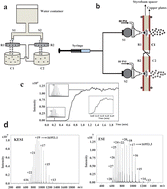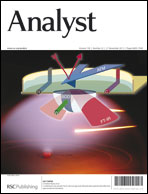Kelvin spray ionization
Abstract
A novel self-powered dual spray ionization source has been developed for applications in mass spectrometry. This new source does not use any power supply and produces both positive and negative ions simultaneously. The idea behind this ionization source comes from the Kelvin water dropper. The source employs one or two syringes, two pneumatic sprays operated over a range of flow rates (0.15–15 μL min−1) and gas pressures (0–150 psi), and two double layered metal screens for ion formation. A variable electrostatic potential from 0 to 4 kV can be produced depending on solvent and gas flow rates that allow gentle ionization of compounds. There are several parameters that affect the performance during ionization of molecules including the flow rate of solvent, gas pressure, solvent acidity, position of spray and metal screens with respect to each other and distance between metal screens and the counter electrode. This ionization method has been successfully applied to solutions of peptides, proteins and non-covalent complexes. In comparison with ESI, the charge number of the most populated state is lower than that from ESI. It indicates that this is a softer ionization technique and it produces more protein ions with folded structures. The unique features of Kelvin spray ionization (KeSI) are that the method is self-powered and ionization occurs at very low potentials by providing very low internal energy to the ions. This advantage can be used for the ionization of very fragile molecules and investigation of non-covalent interactions.


 Please wait while we load your content...
Please wait while we load your content...